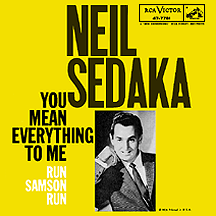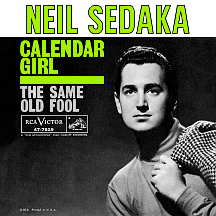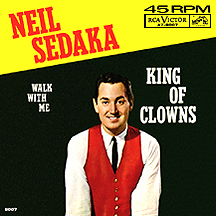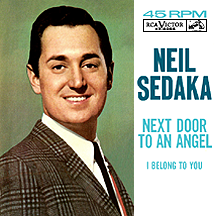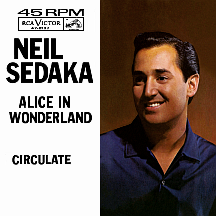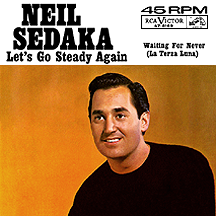NEIL SEDAKA
If Neil Sedaka had done nothing more than write songs, his name would rank among the most successful pop composers of the past five or six decades. But like Johnny Rocco (portrayed so nefariously by Edward G. Robinson in Key Largo), he wanted more. And as time marched on (referencing one of the several hundred songs he's written), that's exactly what he got. It started during his childhood in Brooklyn, New York's Brighton Beach district, when his second grade teacher observed a level of musical ability unusual for someone his age. This led to piano lessons, and those led to a scholarship to study classical piano at New York's Juilliard School of Music. His parents, Mac and Eleanor Sedacca, were supportive, going so far as to take second jobs for periods of time in order to make extra money for Neil to continue his music education.
While in junior high, he met Howard Greenfield, whose interest in poetry was a perfect fit for his non-lyrical music interests. By the time Neil had entered high school in the mid-'50s, he was leaning away from classical music and looking for ways to make it as a songwriter or, perhaps, even a rock and roll singer. With a few of his classmates at Abraham Lincoln High School, including Hank Medress, Jay Siegel and Cynthia Zolotin, he put together a doo wop group called The Tokens. The Melba label released "I Love My Baby," written by Sedaka (the "k" a permanent part of his stage name by this time) and Greenfield. The song, featuring a lead vocal by Medress, received a noticeable amount of airplay in New York during 1956 but it was a tough sell in other markets. Neil sang lead on the single's flip side, "While I Dream." Morty Craft, one of Melba's owners, arranged for him to play the chimes on what turned out to be the label's biggest hit, "Church Bells May Ring" by The Willows. Sedaka had succeeded in breaking into the music business!
Having felt he'd achieved a level of accomplishment as a songwriter, the singing bug had bitten him while with the Tokens and, noticing his cousin Eydie Gorme enjoying some chart success, he left the group, feeling emboldened as he approached some of the bigger labels based in New York (the Tokens continued with Medress fronting a changing lineup; eventually the group scored several hits during the '60s including the number one smash "The Lion Sleeps Tonight"). Decca Records gave Neil a shot and his first and only solo disc for the label was "Laura Lee," released around the end of 1957.
Next up was "Ring-A-Rockin'" on the Legion label, but even an appearance lip-syncing the song on American Bandstand failed to generate interest or airplay. Falling back on the songwriting he felt was his strong suit, he wrote "Never Again" with his brother-in-law Edward Grossman, which Dinah Washington recorded for Mercury Records in the spring of '58. About that time he and Greenfield went to work for Al Nevins and Don Kirshner's Aldon Music publishers and began working out of the Brill Building on Broadway, right in the midst of many large and small record companies. They submitted songs to Connie Francis, but she rejected them as too sophisticated. Her breakthrough hit had been a 35-year-old song, "Who's Sorry Now," but she was set on targeting a younger market and asked if they had any songs geared toward teenagers. They responded with "Stupid Cupid," which became the writing duo's first major hit in the summer of 1958, followed by "Fallin'," another '58 hit for Francis.
"Ring-A-Rockin'," meanwhile, turned out to be more of a career stepping stone than Neil had anticipated; after catching his performance on Bandstand, executives at RCA Victor became interested and signed him to a contract. Little Anthony and the Imperials recorded Neil and Howard's "The Diary," intending it to be their follow-up single to "Tears on My Pillow," but internal disagreements at End Records resulted in a different song getting the nod. Neil decided to record it with Nevins and Kirshner producing (as they did regularly for the next several years) for his first Victor release, and in January '59 "The Diary" made the top 20 to the dismay of everyone involved with the Imperials and End Records.
Neil kept busy in 1959. Both sides of his career were going well as several Sedaka-Greenfield songs appeared on the charts in quick succession: Atlantic artists LaVern Baker ("I Waited Too Long") and Clyde McPhatter ("Since You've Been Gone") enjoyed top 40 hits with S&G tunes, Francis went top ten with "Frankie" and Roy Hamilton did "Time Marches On." Neil's second RCA single was the piano-pounding rocker "I Go Ape," after which he sat in on Bobby Darin's session for "Dream Lover" and "Bullmoose," contributing a driving Jerry Lee Lewis-style piano performance on the latter track. Carole King, another Brill Building songwriter, had dated Neil at one point and found herself the subject of his next single, "Oh! Carol" (using her original first name spelling); it was his first top ten hit in December 1959. She responded by releasing an "answer" variation of the song on the Alpine label, "Oh, Neil!" (writer credit to Sedaka, Greenfield and Gerry Goffin, her husband by the time of the song's release and eventual collaborator on more great hits than you can list on a roll of butcher paper). Neil went on to marry Leba Strassberg in 1962 and they also doubled as professional partners; Leba later became his manager.
Hit singles came nonstop for the next few years. In an interview for the 1969 radio "Rockumentary" The History of Rock and Roll, he used the term "sandwich songs" to describe his writing style (as his associates in those days jokingly called it), basically an eight-bar introduction followed by the "crux" of the song and closing with the same eight-bar intro. "Stairway to Heaven" went top ten early in 1960, while he received his first of several Grammy nominations in the category of Best Performance by a Top 40 Artist (for his self-titled RCA album, inexplicably competing against five other artists' nominated singles). Jimmy Clanton hit the top 40 in the spring with one of the songs from that album, "Another Sleepless Night" (Clanton also hit with Neil and Howard's "What Am I Gonna Do" several months later). Sedaka's next single, "You Mean Everything to Me" backed with "Run Samson Run" was his strongest two-sided hit, each separately making the top 40 in the fall.
1961 began with one of his most famous hits, "Calendar Girl" (suggesting 12 images not unlike those on the cover of the the notorious 1956 Julie London album with the same title) and another smash for Connie Francis, "Where the Boys Are." "Little Devil" continued Neil's hit streak, but the next 45, "Sweet Little You," cowritten with Larry Kolber, fell short of the top 40 (though its similarity to Ernie K-Doe's number one hit "Mother-In-Law" may have hindered the song's progress). Another collaboration with Greenfield near the end of the year, "Happy Birthday, Sweet Sixteen," sent him back to the top ten. "King of Clowns" had a brief chart run in the spring of 1962, and if it appeared that his hitmaking powers were weakening, the next single laid rest to that theory. "Breaking Up is Hard to Do" entered the charts in June and hit number one in August, becoming his signature song (its 'come-a come-a down-doo-be-doo-down-down' stuck in everyone's heads ever since). "Next Door to an Angel" followed it into the top ten a couple of months later.
"Alice in Wonderland," "Let's Go Steady Again" and "Bad Girl" added to his runs of hits in 1963, but after five years the pop "sandwich" recipe was wearing thin. He recorded "It Hurts to Be in Love," which Greenfield composed with Helen Miller, but due to a legal entanglement with RCA, it was Gene Pitney's release, using Sedaka's instrumental track, that made the song a hit (top ten in September '64). Things went downhill from there; the low budget 1965 film Sting of Death featured a curiously strange ska-beat tune written and performed by Neil, "Do the Jellyfish." With mid-decade sales and airplay gradually growing weaker, he and RCA Victor parted ways in 1966.
Neil spent more time behind the scenes of the business in the late 1960s. Through Kirshner, he became part of the creative team behind The Monkees' explosion, contributing "When Love Comes Knocking (At Your Door)" (cowritten with Carole Bayer) to the group's second album, More of the Monkees, in 1967. Neil also played piano on many tracks and produced a number of Monkees sessions during the group's run of chart-topping success. Another pop-rock band, The Cyrkle, hit the charts with Neil and Howard's "We Had a Good Thing Goin'" in the spring of '67. "Workin' on a Groovy Thing" (a collaboration with Brill Building writer Roger Atkins) was a hit for both Patti Drew in '68 and The 5th Dimension in '69. A minor acting role in the 1968 Canadian film Playgirl Killer (released in the U.S. as Portrait of Fear) included a performance of throwaway tune "Waterbug" and suggested he wouldn't be continuing down a movie career path.
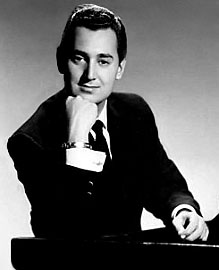
Lenny Welch hit the top 40 at the beginning of 1970 with a jazzy ballad arrangement of "Breaking Up is Hard to Do" that would have an impact on Sedaka's own career several years later. While making the occasional album and achieving popularity in several foreign countries, Neil continued penning hit songs in the early 1970s: "Puppet Man" (by the 5th Dimension in '70 and Tom Jones a year later) and "Rainy Jane" (a solo single by Monkee Davy Jones in '71). Living in England during this time, he began writing songs with Phil Cody, leading to his comeback as a recording act, one of the most spectacular for any artist during the 1970s. After meeting Elton John, he signed with John's Rocket Records label. Lea Roberts had recorded the Sedaka-Cody song "Laughter in the Rain," which hit the R&B charts in September 1974; Neil's version entered the pop charts a month later and steadily moved upward, becoming his second number one hit in February '75.
Over the next two years Sedaka enjoyed a run of hits comparable to his early-'60s peak. "The Immigrant" was inspired by John Lennon's well-publicized efforts to avoid deportation. Meanwhile, the summer '75 chart-topper "Love Will Keep Us Together" (penned with Greenfield) made The Captain and Tennille an overnight success (and was the year's biggest hit, to boot) and The Carpenters took "Solitaire" (which he'd written with Cody) into the top 20. "Bad Blood," with backup vocals by Elton John, gave Neil his third number one as a singer in October, then in early '76 his adaptation of "Breaking Up is Hard to Do" (based on Charlie Calello's arrangement of the 1970 Lenny Welch hit) brought the song back to the top ten in a rare case of two distinctly different recordings of the same song, by the same artist, becoming a hit a second time.
"Lonely Night (Angel Face)" (with music and lyrics by Neil) added another highlight to the Captain and Tennille's hot streak in early 1976. "Love in the Shadows" and "Steppin' Out" added to his own hit list, which extended to 1980 with "Should've Never Let You Go," a duet with his 17-year-old daughter Dara Sedaka (who had written a couple of his Rocket label B sides a half-decade earlier). Neil Sedaka's music remained vital through his appearances on American Idol; he was the first of literally dozens of older artists invited to appear as mentors and performers on the most successful TV series of the 21st century so far. Today the "sandwich song" expert continues recording and making live concert appearances while raking in royalties from the many pop culture classics he's written (with the help of Greenfield, Cody and others, of course) throughout these past 50-plus years.
NOTABLE SINGLES:
- I Love My Baby /
While I Dream - 1956
by The Tokens - Laura Lee - 1957
- Ring-A-Rockin' - 1958
- The Diary - 1958
- I Go Ape - 1959
- Crying My Heart Out For You - 1959
- Oh! Carol /
One Way Ticket (To the Blues) - 1959 - Stairway to Heaven - 1960
- You Mean Everything to Me /
Run Samson Run - 1960 - Calendar Girl - 1961
- Little Devil - 1961
- Sweet Little You - 1961
- Happy Birthday, Sweet Sixteen - 1961
- King of Clowns - 1962
- Breaking Up is Hard to Do - 1962
- Next Door to an Angel - 1962
- Alice in Wonderland - 1963
- Let's Go Steady Again - 1963
- The Dreamer - 1963
- Bad Girl - 1963
- Sunny - 1964
- I Hope He Breaks Your Heart - 1964
- The World Through a Tear - 1965
- The Answer to My Prayer - 1966
- Rainy Jane - 1969
- Laughter in the Rain - 1974
- The Immigrant - 1975
- That's When the Music Takes Me - 1975
- Bad Blood - 1975
- Breaking Up is Hard to Do - 1976
- Love in the Shadows - 1976
- Steppin' Out - 1976
- Should've Never Let You Go - 1980
with Dara Sedaka


